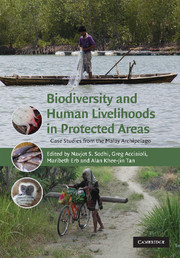Book contents
- Frontmatter
- Contents
- List of contributors
- Acknowledgements
- 1 General introduction
- Part I Conservation needs and priorities
- 2 Introduction to Part I
- 3 Delineating Key Biodiversity Areas as targets for protecting areas
- 4 A Master Plan for Wildlife in Sarawak: preparation, implementation and implications for conservation
- 5 Indonesia's protected areas need more protection: suggestions from island examples
- 6 Birds, local people and protected areas in Sulawesi, Indonesia
- 7 Importance of protected areas for butterfly conservation in a tropical urban landscape
- 8 Biodiversity conservation and indigenous peoples in Indonesia: the Krui people in southern Sumatra as a case study
- 9 Involving resource users in the regulation of access to resources for the protection of ecosystem services provided by protected areas in Indonesia
- 10 Conclusion to Part I
- Part II Conservation with and against people(s)
- Part III Legal and governance frameworks for conservation
- 29 General conclusion
- Index
- References
6 - Birds, local people and protected areas in Sulawesi, Indonesia
from Part I - Conservation needs and priorities
Published online by Cambridge University Press: 12 November 2009
- Frontmatter
- Contents
- List of contributors
- Acknowledgements
- 1 General introduction
- Part I Conservation needs and priorities
- 2 Introduction to Part I
- 3 Delineating Key Biodiversity Areas as targets for protecting areas
- 4 A Master Plan for Wildlife in Sarawak: preparation, implementation and implications for conservation
- 5 Indonesia's protected areas need more protection: suggestions from island examples
- 6 Birds, local people and protected areas in Sulawesi, Indonesia
- 7 Importance of protected areas for butterfly conservation in a tropical urban landscape
- 8 Biodiversity conservation and indigenous peoples in Indonesia: the Krui people in southern Sumatra as a case study
- 9 Involving resource users in the regulation of access to resources for the protection of ecosystem services provided by protected areas in Indonesia
- 10 Conclusion to Part I
- Part II Conservation with and against people(s)
- Part III Legal and governance frameworks for conservation
- 29 General conclusion
- Index
- References
Summary
Introduction
Given the rapid loss of tropical forests (Achard et al. 2002) and the probable consequent extinction of native biotas (Sodhi et al. 2004a), protected areas (PAs) are pivotal for the conservation of remaining biodiversity (Rodrigues et al. 2004). However, the disappearance and degradation of tropical forests both within and outside the borders of PAs (e.g. commercial logging and agricultural encroachment; Curran et al. 2004), continues to undermine their ecological value (Liu et al. 2001). It is therefore important to determine the conservation value and underpinnings of resource harvesting in PAs.
Apparent conflicts between conservation and development could possibly have been avoided if biological and social knowledge were considered during land-use planning, including the design of PA networks (Terborgh et al. 2002; but see Kremen et al. 1999). Poor ecological and sociological data are impeding conservation efforts in Southeast Asia (Sodhi et al. 2004b). Southeast Asian biotas harbour high proportions of endemism (Myers et al. 2000) and the region is expected to suffer a loss of up to 21% of its biodiversity by 2100 if present deforestation rates continue (Brook et al. 2003). The Indonesian island of Sulawesi has extraordinary levels of endemic fauna (e.g. 61% and 34% of mammals and birds are endemic, respectively) and is experiencing both intensive human encroachment pressure in PAs and high deforestation rates (Sodhi & Brook 2006). Much of this negative impact, in part, stems from human resettlement close to the PA fringes as part of a nationwide transmigration project (Whitten et al. 2002).
- Type
- Chapter
- Information
- Biodiversity and Human Livelihoods in Protected AreasCase Studies from the Malay Archipelago, pp. 78 - 94Publisher: Cambridge University PressPrint publication year: 2007



